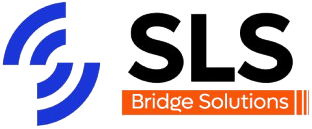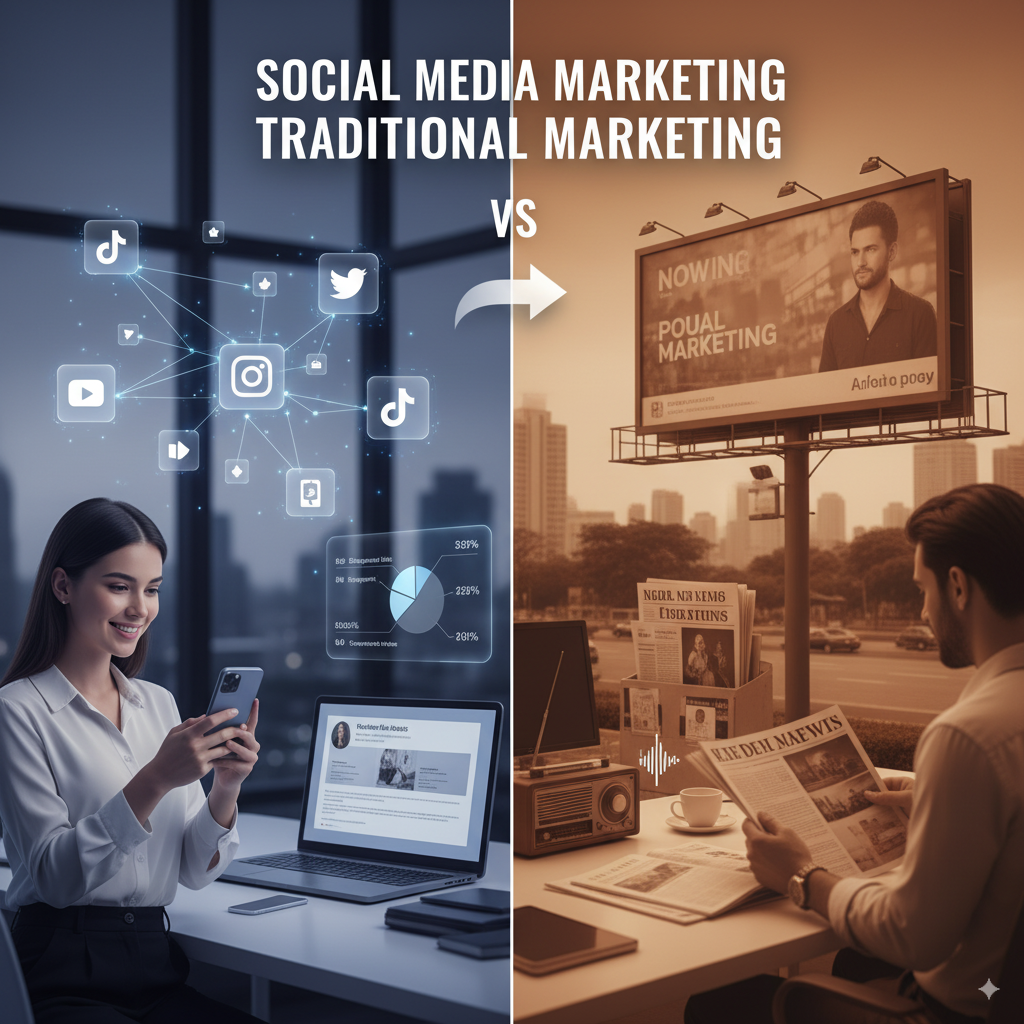Marketing has always been about showing up where people spend their time. Years ago, that meant TV commercials, radio jingles, newspaper ads, and billboards. These channels worked because that’s where audiences were focused.
Today, the attention has shifted. Instead of reading newspapers or watching prime-time TV, people scroll through Facebook, Instagram, TikTok, LinkedIn, and YouTube. These platforms act like the new billboards and TV screens but with one major difference: they’re interactive. Audiences can like, comment, share, and even shop directly from an ad.
With so many options, the big question is: Which works better in 2025, social media marketing or traditional marketing? Let’s break it down.
What Is Traditional Marketing?
Traditional Marketing is the use of offline, non-digital methods to promote products, services, or brands. It’s the form of marketing that existed long before the internet and is still in use today.
Traditional marketing covers offline channels like:
1. TV and Radio Advertising
This means running commercials on television or radio stations to reach large audiences. It works well for building brand awareness because so many people tune in daily. For example, a beverage company might air a catchy radio jingle or a 30-second TV ad during a popular show. The downside is that it’s very costly, and unlike digital ads, it’s difficult to measure exactly how many sales come from it.
2. Newspaper and Magazine Ads
These involve placing advertisements in print publications, whether in daily newspapers or niche magazines. This method works well for reaching specific groups. For example, a luxury watch brand might advertise in a high-end lifestyle magazine to target wealthy readers. A local real estate company could also run ads in the weekend property section of a newspaper to connect with potential buyers. The challenge, however, is that print readership has dropped in the digital age, and it’s harder to measure the direct results compared to online ads.
3. Billboards and Posters
These are large outdoor advertisements placed in busy areas where lots of people can see them. They work because of their strong visibility, commuters and passersby are exposed to them daily, making them hard to miss. For example, a telecom company might promote a new data plan on a massive highway billboard to catch attention quickly. The downside is that they’re expensive and mainly good for awareness, since there’s no direct way for customers to interact with the ad.
4. Flyers, Brochures, and Direct Mail
These are printed materials that businesses hand out, share in detail, or send directly to people’s homes. They work well for local businesses because they put something physical in the customer’s hand, which can be more memorable than a digital ad. For example, a neighborhood restaurant might hand out flyers with its menu and discount coupons to attract nearby customers. The drawback is that many people throw these materials away, and the costs of printing and distribution can add up quickly..
In short, these methods all focus on offline visibility and mass reach. They’re great for credibility and awareness, but weaker at targeting, personalization, and tracking compared to digital marketing.
These methods are powerful for mass exposure but often expensive. Tracking results is also difficult, you can’t always know how many sales came from a billboard or a print ad.
What Is Social Media Marketing?
According to Statista, billions of people spend hours daily on social platforms, Social Media Marketing is the use of social media platforms like Facebook, Instagram, TikTok, LinkedIn, X (Twitter), and YouTube to promote products, services, or brands. It’s a branch of digital marketing that focuses on connecting with audiences where they spend much of their time on social apps.
Social media marketing uses online platforms to reach audiences. This includes:
- Organic Posts include photos, videos, stories, and reels that businesses share for free on platforms like Instagram, Facebook, TikTok, or LinkedIn. These posts help brands showcase their personality, share updates, and connect with followers naturally. For example, a fashion brand might post daily outfit inspiration reels to keep its audience engaged without spending on ads.
- Paid Ads allow businesses to target specific groups based on age, location, interests, or behavior. Unlike organic posts, paid ads put content in front of people who may not follow the brand yet but are likely to be interested. For instance, an online store could run Facebook ads targeting young professionals interested in fitness gear.
- Influencer Partnerships involve collaborating with individuals who have a strong following and influence on social media. Brands partner with influencers to promote their products in a more authentic way, since people trust recommendations from creators they follow. For example, a skincare brand might work with a beauty influencer to showcase how their product fits into a daily routine.
- Community Building happens through consistent engagement; likes, shares, comments, and direct messages. This two-way interaction helps brands build trust and long-term relationships with their audience. For example, a coffee shop might reply to customer comments, repost user-generated content, and run polls on Instagram stories to strengthen its online community.
Key Differences Between the Two
| Aspect | Traditional Marketing | Social Media Marketing |
|---|---|---|
| Reach | Wide but general | Global and highly targeted |
| Cost | High (production + distribution) | Flexible (low to high budgets) |
| Measurement | Difficult to track | Easy with analytics |
| Engagement | One-way communication | Two-way, interactive |
| Speed | Slower, takes time to launch | Instant updates and posts |
Traditional Marketing Pros
- Builds trust and credibility: Seeing a brand on TV, in newspapers, or on billboards often makes it feel established and reliable.
- Reaches large local audiences: TV and radio ads can reach thousands of people in a region at once, which is useful for local or national campaigns.
- Strong brand visibility: Billboards or posters in busy areas keep your brand in front of people repeatedly, making it memorable.
Traditional Marketing Cons
- Expensive: Running TV commercials or printing ads in newspapers costs a lot, making it harder for small businesses to compete.
- Hard to measure results: It’s difficult to know exactly how many people saw a billboard or bought something because of a TV ad.
- Limited interaction: Traditional ads are one-way—you talk to the audience, but they can’t talk back immediately.
Social Media Marketing Pros
- Cost-effective: You can market your business for free with organic posts or run paid ads with any budget.
- Easy to track results: Analytics tools show you likes, clicks, shares, and even sales in real time, so you know what’s working.
- Personalized targeting: Ads can be tailored to age, location, interests, or behavior—making them more effective.
- Encourages interaction: Customers can comment, message, and share your posts, helping you build a real relationship with your audience.
Social Media Marketing Cons
- Needs constant content: To stay relevant, you have to post regularly and keep up with trends.
- Algorithm changes: Platforms like Instagram or TikTok update how they show content, which can suddenly reduce your reach.
- High competition: Millions of brands are online, so it can be tough to stand out without a strong strategy.
Which Works Better in 2025?
In 2025, social media marketing clearly has the advantage for most businesses. Here’s why:
- People spend more time online than offline media. On average, users spend several hours a day scrolling through TikTok, Instagram, Facebook, LinkedIn, and YouTube. That means social media is where attention is concentrated, making it the best place for brands to show up.
- AI makes targeting smarter. Social platforms now use advanced AI to understand user behavior. what people search for, what they watch, and even what they’re likely to buy. This allows businesses to run highly targeted ads that reach the right people at the right time, increasing conversions while reducing wasted ad spend.
- Social platforms double as shopping hubs. With features like TikTok Shop, Instagram Shopping, and Facebook Marketplace, customers don’t just see ads; they can purchase products directly inside the app. This smooth buying process makes social media a powerful sales channel, not just a place for awareness.
However, this doesn’t mean traditional marketing is irrelevant. It still plays a role in certain industries:
- Politics: Campaigns rely on billboards, posters, and TV ads to reach broad audiences quickly.
- Luxury brands: High-end fashion, jewelry, and cars often use glossy magazine spreads or outdoor ads to convey prestige.
- Local services: Small shops, restaurants, and community events sometimes benefit more from flyers, posters, and radio ads than from digital platforms.
The reality is that while social media leads the way in 2025, traditional marketing continues to add value in industries where physical presence, prestige, or mass visibility matter.
The Best Strategy: Combine Both
The real winner is not choosing one over the other but blending both. For example:
- A fashion brand can use billboards for visibility and Instagram ads for sales.
- A local restaurant can distribute flyers while running Facebook ads for promotions.
This mix balances trust and reach with personalization and measurability.
Conclusion
So, social media Marketing vs traditional marketing: who wins in 2025?
If your goal is cost-effective growth and measurable ROI, social media takes the lead. But if you want brand credibility and broad exposure, traditional marketing still has value.
The smartest businesses in 2025 will combine both, using the credibility of traditional marketing and the precision of social media to get the best results. If you’re finding it difficult to navigate the marketing landscape, fear not. SLS Bridge Solutions, marketing experts are here to help

